#tft display module
Explore tagged Tumblr posts
Text
Key Points of Industrial Control & Outdoor High-Brightness LCD Screens
Industrial control LCD screens are specialized displays designed for demanding environments, with features like wide temperature tolerance (−30°C to +80°C) and high brightness (over 400 nits), ensuring clear visibility under strong light. These are widely used in instrumentation, communication equipment, automation, and outdoor systems.
Analog vs. Digital LCD Panels:
LCD screens differ based on their driver circuits:
Analog input uses a D-SUB interface and converts RGB analog signals to digital within the display.
Digital input uses DVI or similar interfaces, offering better signal integrity and sharper images.High-quality lcd display modules often support both, enhancing compatibility.
Internally, all LCDs operate digitally; the difference lies in how signals are received and processed.
Outdoor High-Brightness LCD Advantages:
Expanding Business Opportunities:
Outdoor lcd display screens are widely adopted in high-traffic areas—airports, malls, museums, metro stations—for advertising and information display. Their clarity, vivid colors, and sunlight readability make them more effective than traditional LED screens.
Low Environmental Impact:
Modern lcd panels minimize radiation and visual pollution, offering a cleaner, safer viewing experience. Customizable solutions adapt to various installations without overwhelming the environment.
Conclusion:
With their durability, clarity, and low energy footprint, industrial and outdoor tft lcd modules, lcd display panels, and touch lcd screens offer powerful display solutions across industries.
Shenzhen Zhiyan Optronics Co., Ltd. (zylcdshop.com) is a reliable China-based supplier with 18+ years of experience in high-performance LCD screens, offering quality products, customized solutions, and competitive factory-direct prices.
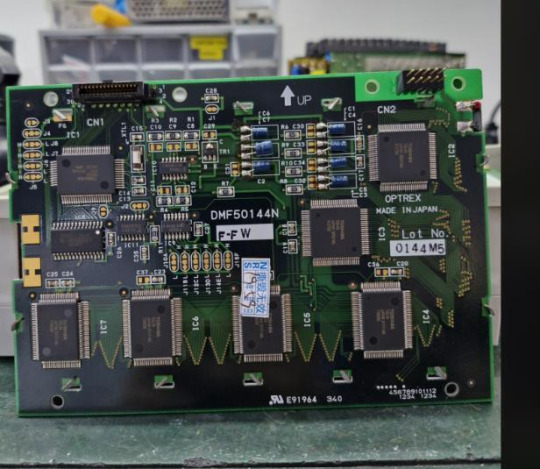
#lcd replacement screen#tft display module#display original#buy lcd panels#tft panel#truly lcd#lcd screen panel#wholesale lcd#replacement screen#wholesale lcd screen#lcd monitor panel#module lcd#tft lcd display module#7 inch display#lcd replacement panels#lcd panel display#display panel#lcd controller board#touch screen lcd display
0 notes
Text
Unleash Creativity with Square LCD Screens
Unleash your creativity and transform your displays with our square LCD screens. Designed for versatility and visual impact, these displays offer a unique canvas for your content, whether you're creating digital art installations or interactive exhibits. With vibrant colors, high resolution, and customizable options, our square LCD screens empower you to bring your vision to life with precision and clarity. Explore our collection and unlock new possibilities with Rondeli Display's innovative solutions. Visit our website to learn more: Square LCD Screen.
#TFT LCD Module#TFT Modules#bar type lcd display#High Brightness LCD#Touch Panel Display#lcd touch screen#Capacitive Touch Screen#lcd display screen#Monochrome Display#Square LCD Screen
2 notes
·
View notes
Text
Leadtekdisplay Premium TFT Modules for Vibrant Displays
Leadtekdisplay's TFT module are cutting-edge display solutions that integrate Thin-Film Transistor technology for exceptional image quality. With vivid colors, high contrast ratios, and detailed visuals, these modules suit a range of applications, including consumer electronics, medical devices, and automotive dashboards. Available in various sizes and specifications, Leadtekdisplay's TFT modules ensure durability and reliability, offering seamless performance in different environmental conditions, from bright sunlight to low-light settings, meeting the highest industry standards.

#touch screen module#touch screen panel#tft modules#tft lcd modules#lcd module#lcd display#7 inch lcd
0 notes
Text
A Practical Guide to Customizing TFT LCD Displays for Embedded Projects
When designing an embedded system, picking the right display module is more than a technical choice — it directly shapes how users interact with your product.
From medical devices and HMIs to industrial controllers and smart panels, standard TFT LCD modules may not always be enough. That’s where custom displays come in — offering flexibility in electrical interface, mechanical layout, and visual performance.
This guide covers the five key areas you should consider when customizing a TFT LCD for your embedded project.
1. FPC Layout and Pin Mapping
The Flexible Printed Circuit (FPC) connects your LCD module to the mainboard, and in custom designs, this interface is often the first thing to change.
Ask yourself:
Do you need a uniquely shaped or angled FPC to fit inside your housing?
Are there ICs, resistors, or other components on the backlight or CTP that require mechanical clearance?
Is your SBC’s connector pinout compatible with the LCD’s FPC layout?
A mismatch here can lead to signal errors, mechanical stress, or even damage to components.
2. Backlight Brightness and Color Temperature
Not all embedded devices live under the same lighting.
If your product is used outdoors or in industrial lighting, consider high-brightness backlights (≥800 nits). For environments where aesthetics and color warmth matter (like smart mirrors or indoor kiosks), choose the right LED color temperature:
3000K (Warm White): Soft, suitable for medical or ambient lighting
5000K (Neutral White): Balanced tone, accurate colors
6500K+ (Cool White): Sharper, more industrial feel
A poorly lit display can make a great device feel underwhelming.
3. Touch Panel Shape and Bonding Options
If your display includes a touch interface, customizing the Capacitive Touch Panel (CTP) is critical.
Typical customizations include:
Round corners, logo cutouts, button holes
Bonding methods:
Optical bonding: Improves visibility, reduces reflections, stronger seal
Air bonding: More affordable and easier to assemble
The bonding method directly impacts touch accuracy, display clarity, and long-term reliability.
4. Surface Treatments: AG, AR, and AF
For devices exposed to bright light or frequent finger contact, display surface treatments make a noticeable difference.
AG (Anti-Glare): Scatters reflected light, improving readability
AR (Anti-Reflection): Enhances contrast in sunlight or strong lighting
AF (Anti-Fingerprint): Reduces smudges, improves touch feel
Combining AG+AF is a common choice for public-facing touchscreen displays.
5. Want to Learn More?
If you’re building with platforms like RK3566, PX30, or Allwinner boards and need a reliable display solution — including driver compatibility and electrical tuning — check out our full technical article:
👉 Read the Full Custom TFT LCD Guide
You can also browse driver/device tree examples on GitHub:
📂 rocktech-tft-display-configs
2 notes
·
View notes
Text
DIY: Marauder with Screen and GPS For Flipper Zero
Many of you would have seen the humongous ESP32 add-on module with touch screen and GPS for Flipper Zero shared in discussion groups, forums, etc. Well, this tutorial will provide you with all the information you need to build one yourself.
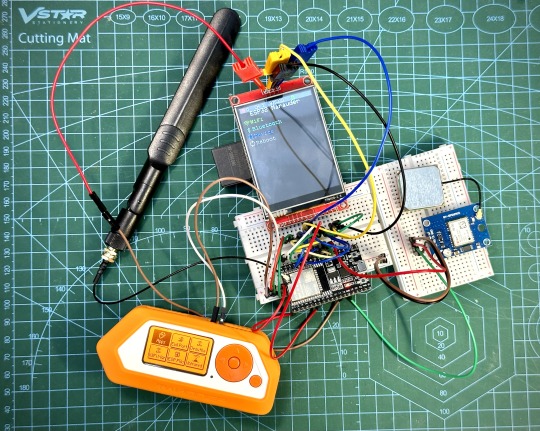
This build consists of mainly 4 parts. The TFT LCD 2.8" 240x320 SPI ILI9341 Touch Display cost me around US$5.50, the ESP32-WROOM-32U module cost around US$3, the NEO-6M GPS module cost around US$2.20 and an 8dbi 2.4GHz Wifi Antenna which cost around US$2. All of these parts can be easily found in online marketplaces like Aliexpress, Amazon, etc. Here is how you need to wire them up together. How you wish to lay this out or mount on a prototyping board is entirely up to you. As long as the connections are correct, you are good to go. The GPS module is optional, and mainly, it's used for the war driving functionality.
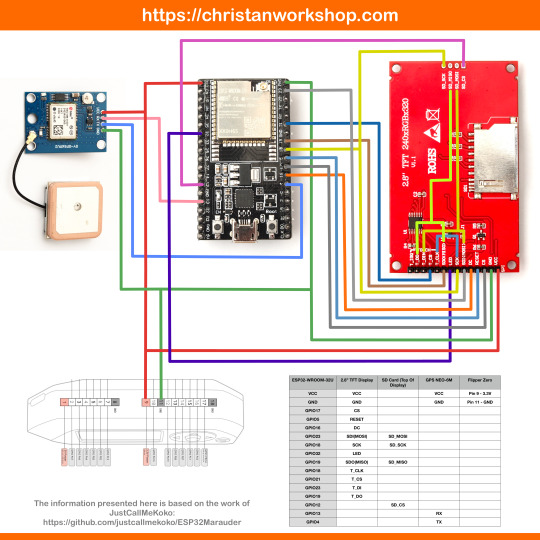
Next, you need to download all the firmware needed from here. Please download the Bootloader, Partitions, Boot App and Firmware files for v4 (Yes, v4 files, not any others) and save it on your computer.
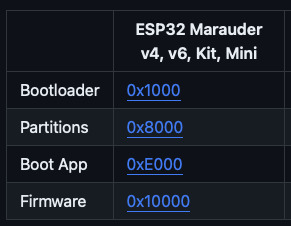
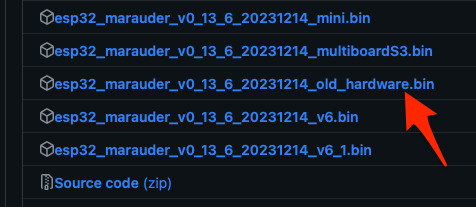
Now, press and hold the BOOT button on your ESP32-WROOM-32U module and connect it to your computer using a data-capable USB cable (some USB cables can only charge), then let go the BOOT button. Open Google Chrome or Microsoft Edge browser and go to ESPWebTool. Click the CONNECT button, then select the ESP32 usb serial connection. It should look something like below but can vary a little between different computers and operating systems.
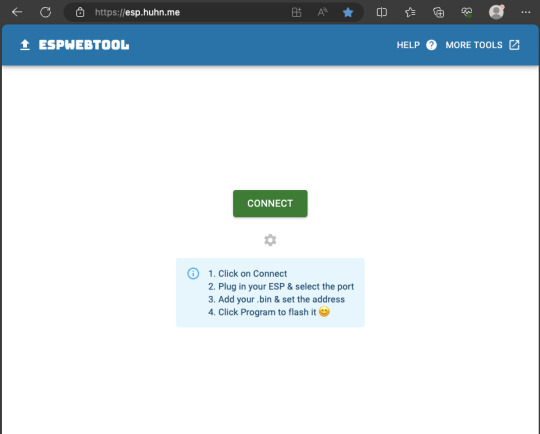
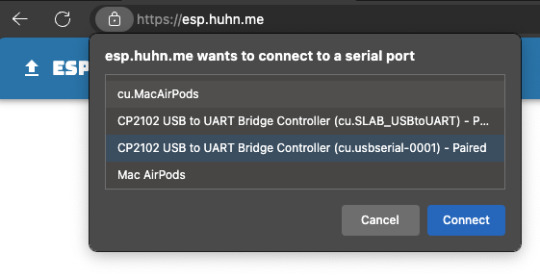
Select the firmware files for each slot exactly like below (take note of the 0x1000, 0x8000, etc. and their corresponding .bin files), then hit the PROGRAM button.
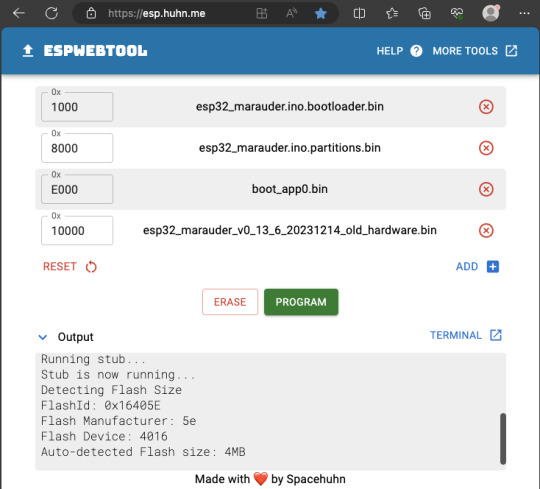
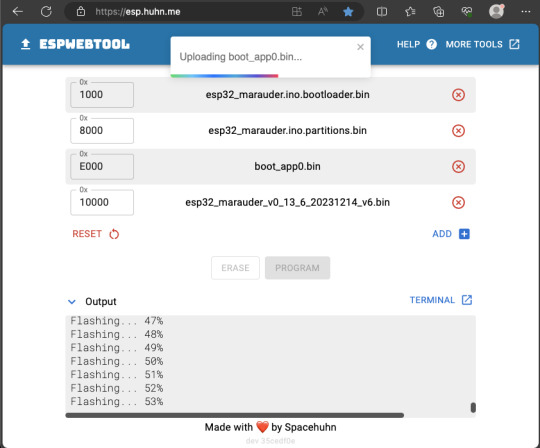
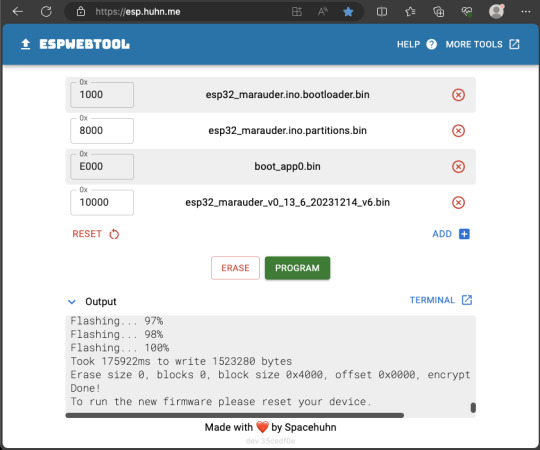
When completed successfully, you can unplug the USB cable from the ESP32 module and now you can connect your Marauder module to your Flipper Zero. Please ensure that your Flipper Zero is turned off before you connect it, and also turn off your Flipper Zero before disconnecting it. The 3.3V pin is also used by your Flipper Zero's SD card reader and connecting/disconnecting external modules that use this pin while the Flipper Zero is on can potentially corrupt the SD card. So, if everything went according to plan, your Marauder module should boot up and everything should look like below.
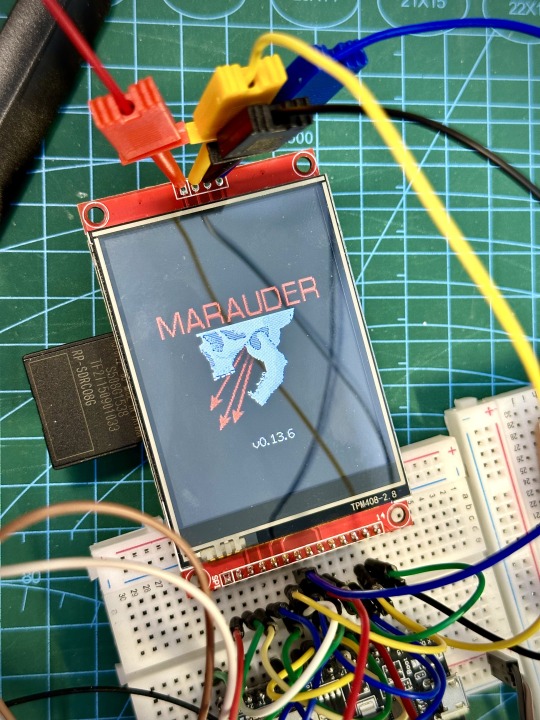
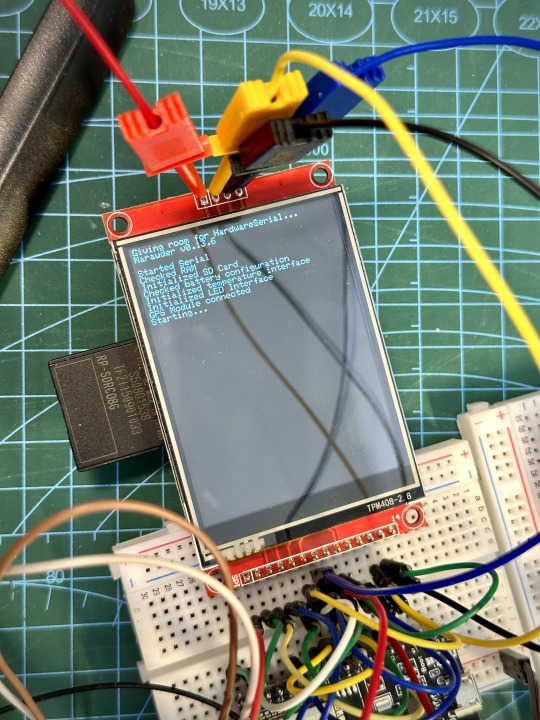
NOTE: If your Marauder boots up, but when you try to touch the screen and get no response, try tapping around the bottom part of your screen and see if the touch panel seems to be in inverted position from the actual display. Should this happen to you, just flash your ESP32 module again following the steps above, but use the v6 firmware. This should resolve the issue.
In this build, I just prototyped this on breadboard, but you can of course make it permanent by soldering it on to a prototype board and 3D print a case for it. This setup is essentially just using the Flipper Zero as a battery pack, instead of using the Flipper Zero to control Marauder. The large screen does make some things easier to do, compared to the small screen of the Flipper Zero, and there may be some functionality (not much) that is not currently in the Flipper Zero Marauder companion app. Here is a video showing the different menus in Marauder.
Personally, I don't think I will actually want to bring something so big around with me, along with my Flipper Zero. I think what makes Flipper Zero special is just how compact it is and all the different functionality cramped into it. This would probably be better off as a standalone unit by just hooking up a battery, but that's just me. Well, that's it for this tutorial. I hope you found this helpful.
Here's a good intro to Marauder if you are unfamiliar.
youtube
18 notes
·
View notes
Text
ICN6211, more working!
we took october off from working on this project, but we're back baby! a PR was submitted to allow DTO-level configuration of display timings , rather than having a specialized driver for each display config which, if merged in by the raspi folks, will mean we don't need to do specialized kernel compilation or module work. at the same time im working on setting up the onboard attiny chip which will be used to configure the ICN6211 over I2C, the TFT over SPI, and manage the backlight. in order to make it possible to 'hot swap' displays without bustin' out a UPDI adapter, we'll store the configuration code in an EEPROM that is exposed over the Pi's DSI I2C port. or at least, that's the idea! we'll see if it works soon :)
5 notes
·
View notes
Text
This 2.4" TFT LCD display module will add up as an awesome display for your Arduino Projects. It can display 240x320 coloured pixels and also has touch screen functionality. The LCD fits directly on top of Arduino UNO as a shield, it is powered by the 3.3V pin on Arduino and communicates through SPI protocol.
3 notes
·
View notes
Text
With a well-established facility located in Shenzhen, China, RisingStar specializes in developing cutting-edge high brightness LCD modules ranging from 2.4 inches to 14 inches, all meticulously engineered to ensure outstanding performance, durability, and readability in even the most demanding applications. Whether you’re designing outdoor digital signage, vehicle information displays, or industrial-grade interfaces, RisingStar offers products that can withstand harsh environmental conditions while maintaining crisp visual clarity.
0 notes
Text
STN Display Module: An Overview of Its Features, Benefits, and Applications
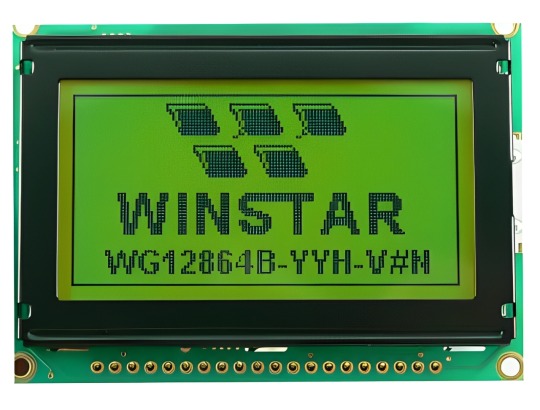
The STN Display Module is a popular choice in various electronic applications due to its versatility, clarity, and reliability. Whether you are designing a compact device or looking for a high-quality display solution, the STN display module offers an impressive array of features. In this blog, we will explore its core advantages, key features, and how it integrates with various components such as connectors, sensors, microcontrollers, and more.
What is an STN Display Module?
STN (Super Twisted Nematic) displays are a type of LCD (Liquid Crystal Display) that are widely used in electronic devices. These displays utilize a unique twisting of liquid crystals to provide clear visual output. The STN display module offers a high contrast ratio, low power consumption, and is available in monochrome or multi-color formats. These features make it an excellent choice for battery-powered and space-constrained applications.
Key Features of STN Display Modules
STN displays are known for their remarkable features, which set them apart from other display technologies.
High Contrast Ratio: STN modules provide excellent contrast, ensuring that the displayed text or images are easy to read under various lighting conditions.
Low Power Consumption: These displays are energy-efficient, which is crucial in battery-operated devices. This makes them ideal for use in portable electronics.
Monochrome and Color Options: Whether you need a simple monochrome display for text or a multi-color one for more complex visual outputs, STN modules offer flexibility.
Compact Size: STN modules come in various sizes, making them suitable for applications with limited space.
Easy Integration: These displays are compatible with a wide range of electronics, making them easy to integrate with other components like microcontrollers, sensors, and more.
Benefits of Using STN Display Modules
The advantages of STN display modules go beyond their basic functionality. Below are some of the main benefits:
Cost-Effective Solution: STN modules are affordable compared to other display technologies like TFT (Thin Film Transistor) or OLED displays. This makes them an ideal choice for cost-sensitive applications.
Durability and Longevity: These modules are designed to withstand various environmental factors, ensuring they perform reliably over time, even in harsh conditions.
Clear Visual Output: With high contrast ratios and the ability to display fine text and detailed images, STN modules provide clear and legible outputs that are easy to read.
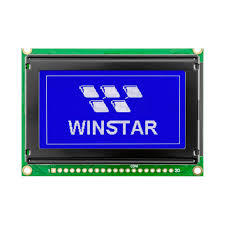
Applications of STN Display Modules
STN display modules are used across a wide range of industries due to their versatility. Here are some common applications:
Portable Devices: These modules are commonly used in devices such as calculators, handheld meters, and other battery-powered equipment where power efficiency is a key consideration.
Industrial Equipment: STN displays are often integrated into industrial control systems, offering clear readouts in machinery, controllers, and safety devices.
Consumer Electronics: From portable gadgets like MP3 players to household appliances, STN displays provide an affordable yet high-performance solution for consumer electronics.
Medical Devices: These displays are also found in medical devices, where clarity and low power consumption are critical, such as in patient monitoring systems and diagnostic tools.
Automotive: In cars and other vehicles, STN displays are used for dashboard instruments, offering high contrast and easy readability.
How STN Display Modules Work with Other Components
STN display modules are often integrated with various electronic components to form a complete system. Below are some components that work seamlessly with STN displays:
Microcontrollers and Microprocessors
These displays are commonly connected to microcontrollers and microprocessors for controlling the display and processing input data. Microcontrollers like Arduino or Raspberry Pi are often used for this purpose.
Connectors
For connecting the STN display module to a system, connectors play a crucial role. They ensure proper communication between the display and the microcontroller or other devices.
Sensors
Many STN display modules are used in sensor applications, displaying data such as temperature, pressure, or humidity readings from sensors.
LEDs
LED backlighting is often used in STN displays to enhance visibility in low-light environments.
Switches and Fuses
For safety, switches and fuses can be integrated with STN display modules to provide user control and protect the system from electrical faults.
Thermal Pads and Grips
When STN displays are used in devices that generate heat, thermal pads can be used to manage the temperature, while grips can offer better handling during use.
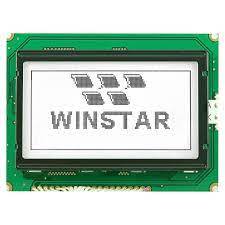
Factors to Consider When Choosing an STN Display Module
When selecting an STN display module, it’s essential to consider several factors to ensure it meets the requirements of your application:
Size: Depending on the space available in your device, choose a display that fits comfortably within the design.
Resolution: Ensure the resolution is suitable for the level of detail required by your application. Higher resolution displays will provide sharper images and text.
Power Consumption: Choose a module with low power consumption if battery life is a concern.
Color vs. Monochrome: Decide whether you need a simple monochrome display or a more vibrant color display for your application.
Compatibility: Make sure the STN display is compatible with the other components in your system, such as the microcontroller, sensors, and connectors.
Conclusion
The STN display module is a powerful, cost-effective solution for a wide range of applications. Its high contrast ratio, low power consumption, and compact size make it an excellent choice for various electronic devices, from industrial machinery to consumer gadgets. By understanding the key features, benefits, and applications of STN display modules, you can select the right module for your project and achieve the desired results.
Whether you’re designing a product with a microcontroller, using sensors for data display, or incorporating LEDs for better visibility, the STN display module is a versatile and reliable option that can elevate your electronic products.
0 notes
Text
Center Stack Display Market Size, Share & Global Demand Report [2025 Updated]

Introduction
We present a comprehensive analysis of the global Center Stack Display Market, emphasizing critical trends, competitive positioning, technological transitions, and future growth prospects. As the automotive industry accelerates toward digitalization and enhanced driver-vehicle interfaces, center stack displays—centralized interactive screens on vehicle dashboards—emerge as essential components in modern vehicles. This center stack display market is projected to expand significantly at a CAGR of 10.7% from 2023 to 2030, driven by increasing consumer demand for connected cars, larger display formats, and advanced infotainment capabilities.
Request Sample Report PDF (including TOC, Graphs & Tables): https://www.statsandresearch.com/request-sample/40358-global-center-stack-display-market
Technological Advancements Driving Center Stack Display Market Expansion
Dominance of TFT LCD Technology
TFT LCD technology commands a substantial portion of the market, holding 81.5% market share as of 2022. These displays offer:
High resolution and superior visual clarity
Lower power consumption
Lightweight design, ideal for automotive integration
While OLED displays are gaining ground for their richer contrast and flexibility, their adoption remains limited by cost and longevity issues under high-temperature environments.
Rise of OLED and Flexible Display Integration
As manufacturers strive for more immersive and customizable user experiences, OLED and flexible displays are anticipated to see increasing penetration post-2025. Their applications will be particularly relevant in luxury and electric vehicles due to:
Deep blacks and superior contrast
Thinner and more curved form factors
Reduced need for backlighting, enabling sleeker designs
Get up to 30%-40% Discount: https://www.statsandresearch.com/check-discount/40358-global-center-stack-display-market
Center Stack Display Market Segmentation by Display Size
Transition Toward Larger Displays
The market share is increasingly concentrated in the “More than 7 inches” segment, which held 70.1% revenue share in 2022. Key reasons include:
Enhanced readability and multitasking capabilities
Better user experience for navigation, media, and car controls
Rising integration of HUDs (head-up displays) and multiple infotainment modules
We forecast sustained dominance of 9-inch and larger displays, especially in autonomous and semi-autonomous vehicles, where they support complex driving data visualization and passenger entertainment simultaneously.
Center Stack Display Market Regional Outlook
North America
North America remains a dominant region, buoyed by strong automotive R&D infrastructure and rapid consumer adoption of in-car digital interfaces. The United States leads with robust demand for SUVs and premium vehicles equipped with sophisticated center stacks.
Asia-Pacific
Asia-Pacific is expected to be the fastest-growing region owing to:
Expansion of automotive manufacturing hubs in China, India, and South Korea
Government incentives for electric and smart vehicles
Increasing consumer expectations for digital infotainment
Europe
Europe sustains steady growth through the presence of luxury automakers like BMW, Mercedes-Benz, and Audi—brands pioneering digital cockpit innovations.
Competitive Landscape
Leading Companies in the Global Center Stack Display Market
We identify the following as key market participants with significant product portfolios and R&D investment:
Continental AG
Panasonic Holdings Corporation
Alpine Electronics, Inc.
HARMAN International
Robert Bosch Manufacturing Solutions GmbH
Texas Instruments Incorporated
Visteon Corporation
MOBIS INDIA LIMITED
MTA S.p.A
PREH GMBH
These firms focus on high-speed processors, AI-enhanced interfaces, and integrated cloud connectivity to differentiate their center stack solutions.
Strategic Center Stack Display Market Trends
Integration with ADAS and AI
Modern center stack displays are evolving into intelligent dashboards, serving as central nodes for:
Adaptive Cruise Control (ACC)
Lane Keeping Assist (LKA)
Driver Monitoring Systems (DMS)
Voice and gesture recognition
These integrations are not merely optional anymore; they are fast becoming standard in mid- and high-tier vehicle segments globally.
Software-Defined Vehicle (SDV) Architecture
The shift toward SDV platforms means that center stacks are now deeply embedded in the vehicle's software layer. With OTA (over-the-air) updates, OEMs can push new features directly to the dashboard, enhancing functionality without physical recalls.
Center Stack Display Market Dynamics
Key Growth Drivers
Escalating demand for luxury and semi-autonomous vehicles
Rising penetration of connected car services
Consumer preference for intuitive and responsive infotainment
Increasing demand for safety, entertainment, and navigation in a single interface
Potential Market Restraints
High development and integration costs
Cybersecurity risks with connected interfaces
Technological fragmentation and lack of standards across OEMs
Center Stack Display Market Value Chain Analysis
Upstream
Raw Material Suppliers: Glass, semiconductors, polymers
Display Component Manufacturers: TFT LCD, OLED panels
Midstream
Display Integration: Automotive electronics firms embedding screens with vehicle software
Downstream
OEMs and Dealerships: Vehicle manufacturers installing center stacks as standard or premium features
Future Outlook: A Digital Command Hub
Center stack displays are no longer limited to basic functions like audio and climate control. By 2030, they will serve as command centers for autonomous driving, immersive entertainment, and AI-powered assistance. This transformation will redefine how drivers interact with their vehicles.
Purchase Exclusive Report: https://www.statsandresearch.com/enquire-before/40358-global-center-stack-display-market
Conclusion
We project the global center stack display market to experience sustained double-digit growth through 2030, reshaping in-car user experiences with advanced digital interfaces. With rapid technological evolution, particularly in the areas of OLED adoption, AI integration, and larger screen sizes, stakeholders across the value chain—from material suppliers to OEMs—must align their strategies to stay competitive in this dynamic market.
Our Services:
On-Demand Reports: https://www.statsandresearch.com/on-demand-reports
Subscription Plans: https://www.statsandresearch.com/subscription-plans
Consulting Services: https://www.statsandresearch.com/consulting-services
ESG Solutions: https://www.statsandresearch.com/esg-solutions
Contact Us:
Stats and Research
Email: [email protected]
Phone: +91 8530698844
Website: https://www.statsandresearch.com
0 notes
Text
Common faults and repairs of LCD monitors
Black screen or no display:
Possible causes: This may be caused by power problems, wiring problems, backlight failure, or a fault in the monitor itself.
Solution: First check whether the power cord is connected properly to ensure a stable power supply. If the power is normal, then the problem may be in the wiring, and you can try to replug the connection cable. If none of the above methods work, you may need to contact a professional repairman for processing.
Color distortion or offset:
Possible causes: This may be caused by signal transmission problems, driver errors, or problems with the monitor itself.
Solution: First check whether the cable connection is firm and ensure that the signal transmission is normal. If the problem persists, you can try to update or reinstall the monitor driver. If the problem still cannot be solved, you may need to consider replacing the monitor.

Uneven brightness:
Possible causes: This may be caused by aging of the backlight, damage to the backlight tube, or other hardware problems.
Solution: Check whether the backlight is evenly illuminated. If you find that the brightness is darker or brighter in some areas, you may need to replace the backlight tube. If the problem persists, it is recommended to contact a professional repairman for diagnosis and repair.
Dead or broken pixels:
Possible causes: This is usually caused by a pixel failure or physical damage to the screen.
Solution: For pixel failures, you can try to use some pixel repair software to fix the dead image. But please note that this does not guarantee a complete fix for all problems. If the problem is severe enough to affect use, the entire monitor may need to be replaced.
About:
Shenzhen Zhiyan Optronics Co., Ltd. (zylcdshop.com) is a reliable China-based distributor specializing in LCD screens. With a strong commitment to quality and customer satisfaction, we deliver premium display solutions and personalized support to meet your specific LCD display needs.
#tft lcd module#panel lcd#replacement lcd screen#tft lcd#panel display#lcd module tft#touch lcd#lcd display 7 inch#screen module#tft lcd screen#lcd supplier#lcd screens replacement#screen lcd display#tft lcd panel#lcd replacement screen#tft display module#display original
0 notes
Text
Illuminate Your Projects with High Brightness LCDs from Rondeli Display
Enhance visibility in any environment with Rondeli Display's high brightness LCD. Engineered for optimal brightness and clarity, our high brightness LCDs ensure outstanding readability even in bright sunlight or dimly lit conditions. Trust Rondeli Display to illuminate your projects with high brightness LCD technology.
#TFT LCD Module#TFT Modules#bar type lcd display#High Brightness LCD#Touch Panel Display#lcd touch screen#Capacitive Touch Screen#lcd display screen#Monochrome Display#Square LCD Screen
2 notes
·
View notes
Text
High-Performance TFT LCD Modules by Leadtekdisplay
Leadtekdisplay TFT LCD modules are high-performance display components utilizing Thin-Film Transistor technology to deliver sharp and vibrant visuals. Widely used in devices ranging from smartphones to industrial equipment, these modules offer superior resolution and color accuracy. Known for their fast refresh rates, they are ideal for applications requiring smooth motion display. Leadtekdisplay provides a variety of sizes and configurations, ensuring flexibility for developers to create customized, user-friendly interfaces that meet diverse industry demands.

#touch screen module#touch screen panel#tft modules#tft lcd modules#lcd module#lcd display#7 inch lcd
0 notes
Text
0 notes
Text
How Customized AUO TFT Displays Are Revolutionizing Modern Electronics
As technology continues to evolve, the demand for high-quality, customizable displays is rapidly increasing. AUO TFT LCD modules are leading the charge, powering devices across industries—from smart home automation to industrial control systems and electric vehicle dashboards.
At SZDFlongwin, we specialize in providing AUO-authorized TFT LCD modules, custom touch panels with logos, and expert lamination services tailored to client needs. Our goal is to deliver reliable, crystal-clear, and long-lasting display solutions to suit all modern applications.
Whether you’re a startup building smart gadgets or an enterprise upgrading industrial machines, choosing the right display makes a difference.
👉 Learn more about our products: https://szdflongwin.com
0 notes